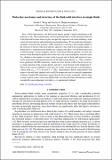Molecular mechanics and structure of the fluid-solid interface in simple fluids
Author(s)
Wang, Gerald Jonathan; Hadjiconstantinou, Nicolas
DownloadPhysRevFluids.2.094201.pdf (2.013Mb)
PUBLISHER_POLICY
Publisher Policy
Article is made available in accordance with the publisher's policy and may be subject to US copyright law. Please refer to the publisher's site for terms of use.
Terms of use
Metadata
Show full item recordAbstract
Near a fluid-solid interface, the fluid spatial density profile is highly nonuniform at the molecular scale. This nonuniformity can have profound effects on the dynamical behavior of the fluid and has been shown to play an especially important role when modeling a wide variety of nanoscale heat and momentum transfer phenomena. We use molecular-mechanics arguments and molecular-dynamics (MD) simulations to develop a better understanding of the structure of the first fluid layer directly adjacent to the solid in the layering regime, as delineated by a nondimensional number that compares the effects of wall-fluid interaction to thermal energy. Using asymptotic analysis of the Nernst-Planck equation, we show that features of the fluid density profile close to the wall, such as the areal density of the first layer Σ[subscript FL] (defined as the number of atoms in this layer per unit of fluid-solid interfacial area), can be expressed as polynomial functions of the fluid average density ρ[subscript ave]. This is found to be in agreement with MD simulations, which also show that the width of the first layer h[subscript FL] is a linear function of the average density and only a weak function of the temperature T. These results can be combined to show that, for system average densities corresponding to a dense fluid (ρ[subscript ave]≥0.7), the ratio C≡Σ[subscript FL]/ρ[subscript ave]h[subscript FL], representing a density enhancement with respect to the bulk fluid, depends only weakly on temperature and is essentially independent of density. Further MD simulations suggest that the above results, nominally valid for large systems (solid in contact with semi-infinite fluid), also describe fluid-solid interfaces under considerable nanoconfinement, provided ρ [subscript ave] is appropriately defined.
Date issued
2017-09Department
Massachusetts Institute of Technology. Department of Mechanical EngineeringJournal
Physical Review Fluids
Publisher
American Physical Society
Citation
Wang, Gerald J. and Nicolas G. Hadjiconstantinou. "Molecular mechanics and structure of the fluid-solid interface in simple fluids." Physical Review Fluids 2, 9 (September 2017): 094201 © 2017 American Physical Society
Version: Final published version
ISSN
2469-990X
2469-9918